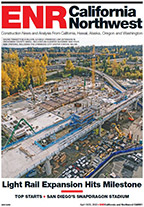Anticipating billions of dollars in state and federal funds, California can now pay some 80 engineering consultants that have worked for months on its planned 800-mile, $46-billion high-speed rail line stretching between Sacramento and San Diego. The Pooled Money Investment Board approved a $29.1-million loan at its April 6 meeting after state Treasurer Bill Lockyer successfully sold $6.54 billion in bonds in March.
The cash-strapped state owes $5 million for scoping and design work on the project. Engineers have worked for months for the California High-Speed Rail Authority without funding authorization. The Roseville, Calif., office of URS Corp., in a preliminary engineering joint venture with London-based Arup Group and Millburn, N.J.-based Hatch Mott MacDonald on the Fresno-to-Palmdale section, hasn’t been paid since October, says Robert Schaevitz, URS vice president. But he says, “The authority is ultimately good for the money.”
California froze infrastructure financing in December. A March 18 letter from Thomas Sheehy, chief deputy director for policy at the California Dept. of Finance, urged firms to “continue their work for the authority as we work out the financing details in the next two weeks.”
The $29.1-million loan will fund operations until the end of the fiscal year, in June. Another bond sale planned for mid-April could keep the project moving ahead. Mehdi Morshed, the authority’s executive director, warned that without the loan he would have to issue stop-work orders. “There is no Plan B,” he says.
Tony Daniels, program director for the authority and senior vice president with New York City-based Parsons Brinckerhoff, says there is some slowdown due to a few engineers suspending work because of nonpayment. He says the postponing of nonessential engineering work could be made up in the long term.
In addition to $9 billion in bonds approved by voters in November, the project is well-positioned to qualify for a chunk of the $8 billion in American Recovery and Reinvestment Act (ARRA) funds dedicated to high-speed rail. Most states do not have planned rail projects capable of 110 mph defined in ARRA guidelines, let alone the 220-mph goal proposed in California’s Sacramento-San Diego link.
“We are in an excellent position to take advantage of those funds,” says Quentin L. Kopp, chairman of the authority. He identifies $3.6 billion in specific projects, including grade separations in the Los Angeles-to-Anaheim corridor, storage facilities in Los Angeles and the Bay Area, a heavy maintenance area in the Central Valley and crossings and electrification. The $34-billion first phase is scheduled for completion in 2020.
Half the money must be obligated by Sept. 1, 2009; the rest must be obligated by March 5, 2010. Interim guidelines from the Federal Railroad Administration for distribution of the stimulus dollars are still being developed. “In addition to moving these projects forward as much as two years, [stimulus money would] help make it possible for us to use the state funds, which require a 50% match,” says Morshed.
The first phase, from San Francisco to Anaheim, is divided into eight sections. Engineers are evaluating thousands of alternatives for routes that are elevated, underground, trenched or walled, including 600 planned road crossings. Twin tunnel-boring machines are being considered for a 16-mile to 20-mile tunnel through the Tehachapi Mountains. Construction contracts could be advertised starting in late 2010.


Post a comment to this article
Report Abusive Comment